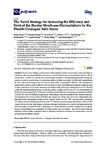The Novel Strategy for Increasing the Efficiency and Yield of the Bipolar Membrane Electrodialysis by the Double Conjugate Salts Stress
| dc.contributor.author | Wang, D | en |
| dc.contributor.author | Meng, W | en |
| dc.contributor.author | Lei, Y | en |
| dc.contributor.author | Li, C | en |
| dc.contributor.author | Cheng, J | en |
| dc.contributor.author | Qu, W | en |
| dc.contributor.author | Wang, G | en |
| dc.contributor.author | Zhang, M | en |
| dc.contributor.author | Li, S | en |
| dc.date.accessioned | 2020-07-09T05:30:21Z | |
| dc.date.available | 2020-07-09T05:30:21Z | |
| dc.date.issued | 2020-02-05 | en |
| dc.identifier.uri | http://hdl.handle.net/10026.1/15858 | |
| dc.description.abstract |
<jats:p>To improve sulfuric acid recovery from sodium sulfate wastewater, a lab-scale bipolar membrane electrodialysis (BMED) process was used for the treatment of simulated sodium sulfate wastewater. In order to increase the concentration of sulfuric acid (H2SO4) generated during the process, a certain concentration of ammonium sulfate solution was added into the feed compartment. To study the influencing factors of sulfuric acid yield, we prepared different concentrations of ammonium sulfate solution, different feed solution volumes, and different membrane configurations in this experiment. As it can be seen from the results, when adding 8% (NH4)2SO4 into 15% Na2SO4 under the experimental conditions where the current density was 50 mA/cm2, the concentration of H2SO4 increased from 0.89 to 1.215 mol/L, and the current efficiency and energy consumption could be up to 60.12% and 2.59 kWh/kg, respectively. Furthermore, with the increase of the volume of the feed compartment, the concentration of H2SO4 also increased. At the same time, the configuration also affects the final concentration of the sulfuric acid; in the BP-A-C-BP (“BP” means bipolar membrane, “A” means anion exchange membrane, and “C” means cation exchange membrane; “BP-A-C-BP” means that two bipolar membranes, an anion exchange membrane, and a cation exchange membrane are alternately arranged to form a repeating unit of the membrane stack) configuration, a higher H2SO4 concentration was generated and less energy was consumed. The results show that the addition of the double conjugate salt is an effective method to increase the concentration of acid produced in the BMED process.</jats:p> | en |
| dc.format.extent | 343 - 343 | en |
| dc.language | en | en |
| dc.language.iso | en | en |
| dc.publisher | MDPI AG | en |
| dc.title | The Novel Strategy for Increasing the Efficiency and Yield of the Bipolar Membrane Electrodialysis by the Double Conjugate Salts Stress | en |
| dc.type | Journal Article | |
| plymouth.issue | 2 | en |
| plymouth.volume | 12 | en |
| plymouth.journal | Polymers | en |
| dc.identifier.doi | 10.3390/polym12020343 | en |
| plymouth.organisational-group | /Plymouth | |
| plymouth.organisational-group | /Plymouth/Faculty of Science and Engineering | |
| plymouth.organisational-group | /Plymouth/Faculty of Science and Engineering/School of Engineering, Computing and Mathematics | |
| plymouth.organisational-group | /Plymouth/REF 2021 Researchers by UoA | |
| plymouth.organisational-group | /Plymouth/REF 2021 Researchers by UoA/UoA11 Computer Science and Informatics | |
| plymouth.organisational-group | /Plymouth/Users by role | |
| plymouth.organisational-group | /Plymouth/Users by role/Academics | |
| dcterms.dateAccepted | 2020-01-25 | en |
| dc.rights.embargodate | 2020-07-16 | en |
| dc.identifier.eissn | 2073-4360 | en |
| dc.rights.embargoperiod | Not known | en |
| rioxxterms.versionofrecord | 10.3390/polym12020343 | en |
| rioxxterms.licenseref.uri | http://www.rioxx.net/licenses/all-rights-reserved | en |
| rioxxterms.licenseref.startdate | 2020-02-05 | en |
| rioxxterms.type | Journal Article/Review | en |


